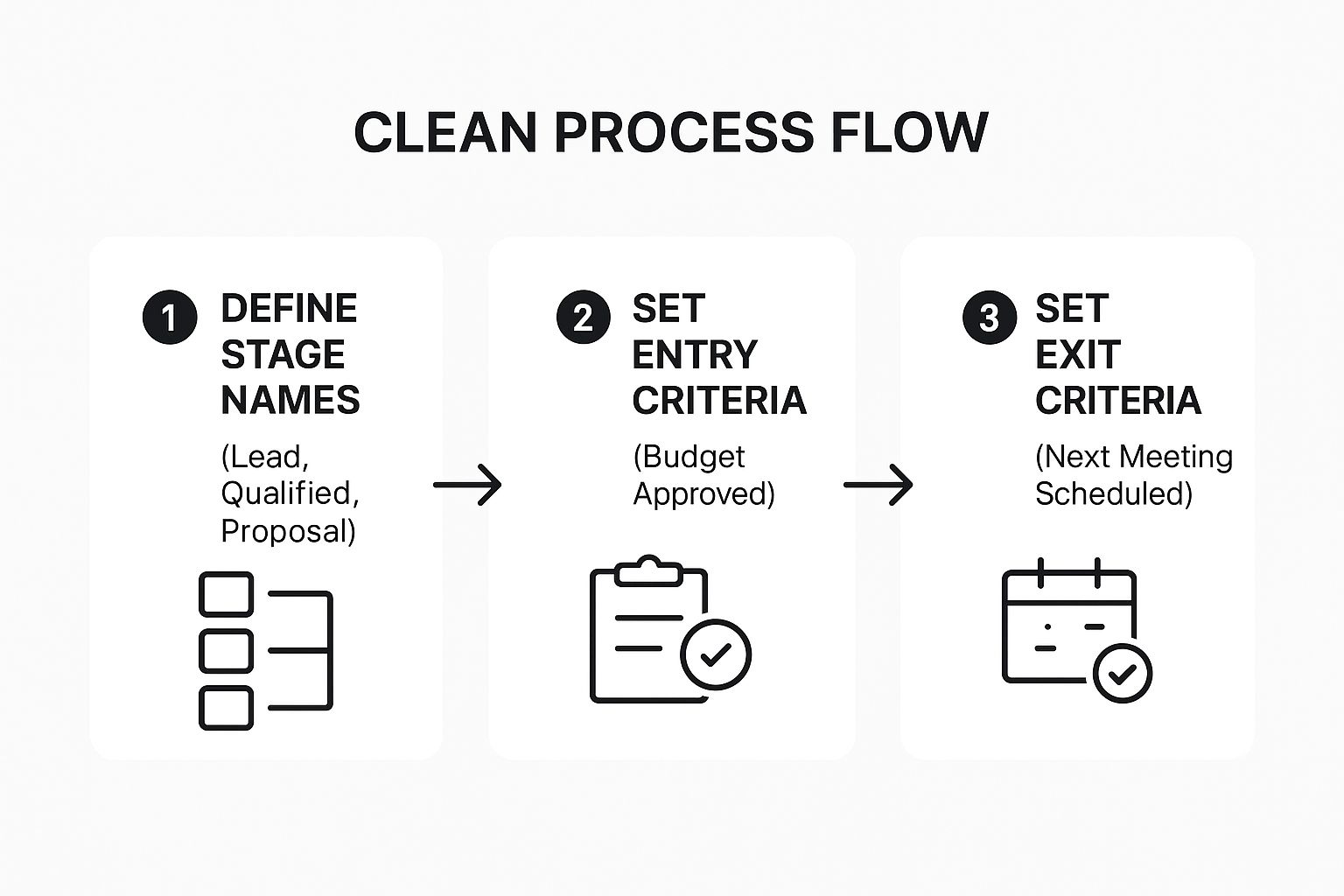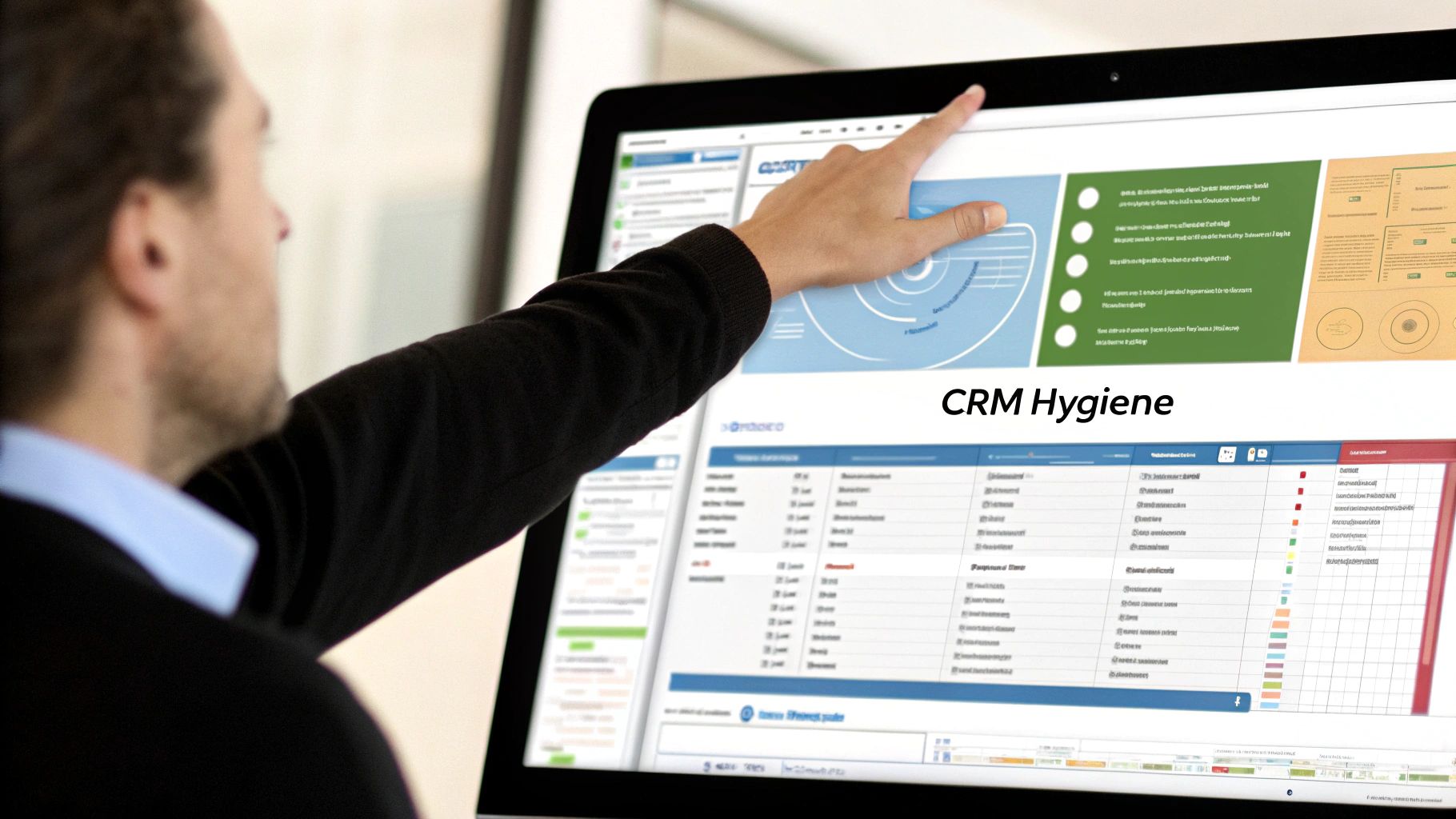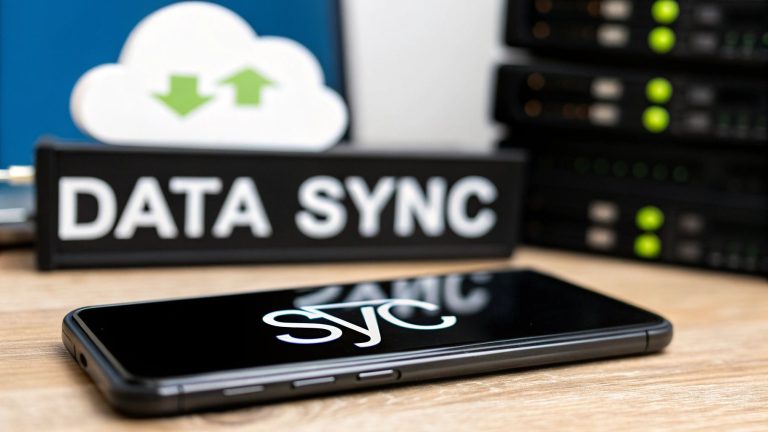8 Actionable Sales Pipeline Management Tips for 2025
A well-managed sales pipeline is the engine of any successful sales organization. It's more than just a list of prospects; it's a strategic roadmap that guides your team from initial contact to a closed deal. However, many pipelines become cluttered, inaccurate, and ultimately ineffective, leading to stalled deals, missed forecasts, and frustrated reps. Common pain points like inconsistent data, undefined sales stages, and a lack of focus on high-probability leads can cripple revenue growth. This isn't just about working harder; it's about working smarter.
Effective pipeline management provides a clear, real-time view of your sales health, enabling you to forecast accurately, identify bottlenecks, and coach your team effectively. The challenge often begins at the very top of the funnel: capturing and organizing leads efficiently. For instance, teams relying on manual downloads from platforms like Facebook Lead Ads often face delays and data entry errors, losing momentum before a prospect is even contacted. This article provides a comprehensive set of sales pipeline management tips designed to transform your process. We will explore actionable strategies to define your sales stages, maintain pristine CRM data, and focus on the metrics that truly drive results, ensuring your pipeline becomes a predictable and powerful revenue-generating machine.
1. Define Clear Sales Stages and Criteria
A disorganized sales pipeline is a primary cause of inaccurate forecasting and missed revenue targets. The foundational step to effective sales pipeline management is establishing a clear, standardized set of sales stages. This framework acts as a roadmap, guiding every opportunity from initial contact to a closed deal with consistent, objective milestones.
Without defined stages, sales reps are left to their own interpretations, leading to a pipeline where one rep’s "Qualified Lead" is another's "Initial Contact." This inconsistency makes it impossible to get an accurate view of sales health or predict future revenue. By creating specific entry and exit criteria for each stage, you ensure every team member assesses opportunities using the same rubric. This standardization is the first and most critical of all sales pipeline management tips.
How to Structure Your Sales Stages
The key is to align your stages with the prospect's buying journey, not your internal sales activities. A typical pipeline contains 5-7 stages to maintain clarity without overcomplicating the process.
For example, a common structure might look like this:
- Prospecting/Lead: A new, uncontacted lead enters the system.
- Qualification: The lead has been contacted and meets basic criteria (e.g., has a need, fits the ideal customer profile).
- Needs Analysis: A discovery call has been completed to understand specific pain points and requirements.
- Proposal/Demonstration: A formal solution has been presented to the prospect.
- Negotiation/Review: The prospect is reviewing the contract, and terms are being discussed.
- Closed Won/Lost: The deal is finalized.
Key Insight: Your sales stages are only as effective as their exit criteria. Vague milestones like "interest shown" are subjective. Instead, use verifiable actions like "demo completed," "budget confirmed," or "decision-maker included in communications."
The infographic below outlines the simple, three-step process for building a robust stage framework.

This process ensures that each stage is meaningful and that transitions between them are based on concrete prospect actions, not guesswork. Regularly review these stages, perhaps quarterly, using win/loss analysis to refine criteria and adapt to changing market dynamics.
2. Implement Regular Pipeline Reviews
A sales pipeline is a dynamic system, not a static list. Without consistent oversight, deals can stall, forecasts become unreliable, and revenue opportunities can slip through the cracks. Implementing regular, systematic pipeline reviews is a critical discipline that shifts the focus from passive monitoring to active management, ensuring momentum and accountability across the sales team.
These reviews are not just status updates; they are strategic sessions designed to pressure-test the health of each opportunity. By scrutinizing deal quality, progression velocity, and realistic close probabilities, you can proactively identify bottlenecks and coach reps on the specific actions needed to advance deals. This proactive approach is one of the most impactful sales pipeline management tips for maintaining a healthy, high-performing sales engine.
How to Conduct Effective Pipeline Reviews
The goal is to foster a coaching environment focused on strategy, not just a simple data read-out. A structured review process keeps meetings efficient and actionable, preventing them from becoming lengthy, unproductive report-outs.
To make your reviews more effective, consider these approaches:
- Weekly Deal Focus: Companies like Zoom hold weekly 30-minute reviews where each rep discusses their top 10 deals. The focus is strictly on verifiable next steps and potential roadblocks.
- Pipeline Hygiene Sessions: Slack is known to implement monthly hygiene sessions where any deal that has been stagnant for over 90 days must either be advanced with a clear action plan or removed from the pipeline.
- Data-Driven Quarterly Reviews: At a larger scale, Oracle uses quarterly business reviews (QBRs) that incorporate predictive analytics and deep pipeline health metrics to forecast performance and align regional strategies.
Key Insight: The most effective reviews concentrate on future actions, not past activities. Instead of asking "What did you do last week?" ask "What is the specific next step to move this deal forward, and what do you need to make it happen?" This transforms the conversation from an interrogation into a collaborative strategy session.
Documenting action items and insights from each review creates a continuous feedback loop. This process not only keeps individual deals on track but also helps refine your overall sales process, a core component of marketing process optimization. By making these reviews a non-negotiable part of your sales rhythm, you ensure your pipeline remains a clean, accurate, and powerful tool for predictable growth.
3. Maintain Accurate Data and CRM Hygiene
An unreliable sales pipeline is almost always built on a foundation of messy data. Without clean, accurate, and consistently updated information in your CRM, your forecasts become guesswork, and your sales process breaks down. Establishing strict data hygiene practices is a non-negotiable step for any team serious about effective pipeline management.
This discipline ensures that every data point, from contact details to deal stage, is trustworthy. Companies that neglect CRM hygiene suffer from duplicate records, outdated opportunity statuses, and incomplete information, making it impossible to diagnose pipeline health or make informed strategic decisions. This commitment to data integrity is one of the most critical sales pipeline management tips for achieving predictable revenue growth.

How to Implement Strong CRM Hygiene
The goal is to make accurate data entry the path of least resistance for your sales team. This requires a combination of smart system design, clear team standards, and consistent reinforcement.
Here are four practical ways to enforce data quality:
- Simplify Data Entry: Use dropdown menus, auto-population, and required fields to make it fast and easy for reps to enter complete data. The fewer manual text fields, the lower the risk of error.
- Link Hygiene to Performance: Tie CRM data completion rates to performance metrics or even compensation. For example, Shopify implements weekly data hygiene reports that show completion rates by rep, creating accountability.
- Automate Validation: Implement validation rules in your CRM to prevent reps from saving incomplete records or moving deals forward without key information. For instance, Dropbox requires all opportunity fields to be 100% complete before a deal can advance to the final stages.
- Schedule Regular Audits: Dedicate time each month or quarter for data cleansing "sprints" to find and fix duplicate contacts, merge incomplete records, and purge outdated information.
Key Insight: Your CRM is the single source of truth for your sales organization. Treat it as a strategic asset, not an administrative burden. The quality of the data inside it directly impacts the quality of your sales outcomes and is a core component of CRM-driven lead generation.
By embedding these practices into your sales culture, you transform your CRM from a simple database into a powerful engine for forecasting, strategy, and revenue generation. The effort invested in maintaining data hygiene pays dividends through enhanced pipeline visibility and accuracy.
4. Use Weighted Pipeline and Probability Scoring
Treating a brand-new lead and a deal in the final negotiation stage as having the same value is a recipe for forecasting disaster. A weighted sales pipeline addresses this by assigning a probability percentage to each deal based on its stage. This approach provides a much more realistic view of your expected revenue, preventing over-optimism and enabling smarter resource allocation.
Rather than a simple sum of all potential deal values, a weighted pipeline calculates a forecast based on the likelihood of closing. A $10,000 deal in the proposal stage (e.g., 50% probability) contributes $5,000 to the forecast, while a $10,000 deal in the initial qualification stage (e.g., 10% probability) contributes only $1,000. This methodology is one of the most powerful sales pipeline management tips for moving from hopeful guessing to data-driven prediction.
How to Implement Probability Scoring
The goal is to move beyond generic percentages and toward scores that reflect your actual sales cycle. For instance, companies like Adobe and Microsoft use sophisticated scoring that considers dozens of factors, but you can start with a simple, effective framework.
Here is a common stage-based probability structure:
- Qualification: 10% probability
- Needs Analysis: 25% probability
- Proposal/Demonstration: 50% probability
- Negotiation/Review: 75% probability
- Verbal Commitment: 90% probability
Key Insight: Your initial probabilities are a starting point, not a permanent rule. The most accurate percentages come from analyzing your historical data. Review the actual win rates from each stage over the last 6-12 months to calibrate and refine your scoring model for superior accuracy.
For example, Stripe adjusts its deal probabilities based on factors like the complexity of a potential customer's payment integration needs and the level of engagement from their developer team. Start with a basic model and then layer in unique factors from your sales process, such as deal size, competitive presence, or budget confirmation, to increase the sophistication and accuracy of your forecast.
5. Focus on Pipeline Velocity and Conversion Rates
Merely having a full pipeline isn't enough; you must also ensure opportunities are moving through it efficiently. Focusing on pipeline velocity and conversion rates shifts the goal from simply "more leads" to "more closed deals, faster." This metric-driven approach provides a diagnostic view of your sales process, highlighting exactly where deals slow down or fall through, which is essential for effective sales pipeline management tips.
Pipeline velocity measures the average time it takes for a deal to move from initial contact to a closed win. Low velocity indicates bottlenecks, while poor stage-to-stage conversion rates reveal weaknesses in your process. For example, Atlassian reduced its average sales cycle by 23% by identifying that technical evaluations were the primary bottleneck and providing reps with better resources for that specific stage. This focus turns your pipeline from a static list into a dynamic, performance-oriented system.
How to Improve Velocity and Conversions
Improving these metrics requires a granular understanding of what happens at each stage. Instead of broad-strokes solutions, you need targeted interventions based on data. This allows you to address the root cause of inefficiencies, not just the symptoms.
Here’s how to put this into practice:
- Track Granularly: Segment your velocity data by deal size, industry, and lead source to uncover hidden patterns. You may find that enterprise deals stall in negotiation, while smaller deals fly through.
- Target Weak Links: Identify the stages with the lowest conversion rates and focus your improvement efforts there first. Twilio, for instance, boosted conversions by 15% by implementing stage-specific value propositions to address common objections at their weakest stage.
- Set Realistic Timelines: Use historical velocity data to set accurate expectations with prospects and internal stakeholders, preventing pressure from misaligned timelines.
- Provide Stage-Specific Training: If deals consistently stall at the proposal stage, develop training and resources specifically for creating more compelling proposals.
Key Insight: Don't just measure the overall sales cycle length. Calculate the time-in-stage for every opportunity. This reveals whether a specific stage, like needs analysis or negotiation, is a universal bottleneck that needs immediate attention and process refinement.
6. Qualify Hard and Disqualify Fast
A common pitfall in sales is a bloated pipeline filled with low-quality leads. This creates a false sense of security and wastes valuable sales resources on opportunities that will never close. The solution is to qualify rigorously and disqualify prospects who don't fit your ideal criteria quickly. This counterintuitive approach ensures your team’s energy is focused exclusively on high-potential deals, dramatically improving efficiency and forecast accuracy.
This discipline, championed by methodologies like MEDDIC and Sandler Training, prevents "pipeline clutter." It requires sales reps to be investigators, not just presenters, digging deep early in the process to uncover potential roadblocks. Adopting this mindset is one of the most impactful sales pipeline management tips for any team looking to boost its win rate by concentrating on genuine opportunities.
How to Implement Rigorous Qualification
The goal is to move beyond surface-level interest and confirm genuine purchase intent. This involves systematically evaluating every lead against a predefined set of standards.
For instance, many top-performing companies use strict rules:
- Workday qualifies deals based on specific criteria like company size, immediate budget availability, and an established decision timeline. Prospects who do not meet these initial gates are removed.
- Snowflake employs early-stage technical qualification calls to validate concrete use cases, filtering out any prospects whose needs don't align with their platform's core strengths.
- ServiceNow often implements a 30-60-90 day rule, where any deal showing no meaningful progression within a set period is automatically flagged for review and potential disqualification.
Key Insight: Treat disqualification as a win. Every unqualified lead you remove from the pipeline frees up your team to pursue a better one. Celebrate this efficiency by rewarding reps for maintaining a clean, high-quality pipeline, not just for the volume of deals in it.
To build this discipline, train your team to ask direct, challenging questions about budget, authority, need, and timeline (BANT). Develop a clear set of questions and criteria for each stage, which you can document in a comprehensive lead qualification checklist. This creates a standardized, systematic process for reviewing stalled deals and making decisive go or no-go decisions, ensuring your pipeline reflects true revenue potential.
7. Develop Multi-Threading and Relationship Mapping
Relying on a single point of contact within a target account is one of the most common and riskiest pipeline vulnerabilities. When your champion leaves the company or gets reassigned, the deal stalls or dies completely. Multi-threading is the strategy of intentionally building relationships with multiple stakeholders across different departments and seniority levels within the same organization. This approach creates a resilient web of support for your deal, significantly reducing the risk of a single point of failure.
This strategy transforms a fragile opportunity into a robust, organization-wide initiative. By mapping the political landscape and understanding who influences whom, your team can navigate internal complexities and build consensus more effectively. This is a crucial element of advanced sales pipeline management tips, as it provides insurance against unforeseen personnel changes and accelerates deal velocity by engaging the entire buying committee.

How to Implement Multi-Threading
The goal is to connect with anyone who has a stake in the outcome, from the end-user and technical buyer to the economic buyer and executive sponsor. Major sales organizations like Salesforce often require reps to engage with 4-5 key stakeholders for any significant enterprise deal.
Here’s how to put it into practice:
- Identify Stakeholders: Work with your initial contact to understand the internal decision-making process and identify key players.
- Map Relationships: Use your CRM or dedicated tools to visually map the organizational chart, noting job titles, influence levels, and relationships between contacts.
- Engage Strategically: Connect your team members with their counterparts. For example, have your CTO talk to their Head of Engineering and your CFO connect with their VP of Finance.
- Cultivate Champions: Find and empower internal advocates who can champion your solution in meetings you aren't a part of.
Key Insight: Multi-threading isn’t about going around your primary contact; it’s about building a coalition with them. Frame it as a way to ensure a smooth implementation and gain company-wide buy-in, making your champion look good in the process.
This video from Sandler Training explains the concept of finding and engaging different roles within the buying organization.
By systematically building these connections, you not only increase your chances of closing the current deal but also lay the groundwork for future expansion within the account. It’s a proactive strategy for pipeline health that pays dividends long-term.
8. Implement Deal Coaching and Milestone Reviews
A static pipeline review focused only on numbers often misses the critical "how" and "why" behind deal progression. Implementing structured deal coaching and milestone-based reviews shifts the focus from simply reporting on deals to strategically advancing them. This proactive approach combines managerial oversight with targeted skill development, directly improving close rates and accelerating rep growth.
This method transforms pipeline meetings from interrogations into collaborative, strategy-building sessions. Instead of asking "Is this deal going to close?", managers ask "What is the next strategic milestone, and what support do you need to achieve it?". This is one of the most impactful sales pipeline management tips because it builds a culture of continuous improvement and equips reps to handle complex sales cycles with confidence.
How to Implement Deal Coaching and Milestone Reviews
The goal is to provide strategic guidance at key moments in the sales process. This prevents deals from stalling and ensures reps are using the most effective tactics for each unique opportunity. It blends formal review processes with informal coaching.
Here’s how to structure this approach:
- Establish Milestone Triggers: Set up formal reviews for high-value deals when they reach critical stages, such as moving from "Proposal" to "Negotiation." For example, Zendesk implements mandatory milestone reviews for all deals over a certain value, requiring specific deliverables at each checkpoint.
- Leverage Peer Coaching: Create opportunities for team members to learn from each other. PagerDuty, for instance, uses peer coaching sessions where top performers review challenging deals with other reps, sharing strategies that have proven successful.
- Utilize Technology: Employ tools like Gong to provide AI-powered coaching based on call recordings. These platforms analyze conversations to highlight areas for improvement in objection handling, negotiation, and overall communication.
- Focus on Strategy, Not Just Tactics: During coaching, concentrate on the overall deal strategy. Discuss the prospect's buying committee, competitive landscape, and potential risks rather than just a rep's next scheduled call.
Key Insight: Effective deal coaching is forward-looking. Instead of dissecting past mistakes, focus on defining the next best action and the key performance indicators that signal genuine progress. Document successful strategies to build a team-wide playbook.
By embedding coaching and strategic reviews directly into your pipeline management workflow, you empower your team to not only forecast more accurately but also to actively shape deal outcomes and drive revenue growth.
Sales Pipeline Management Tips Comparison
| Item | Implementation Complexity 🔄 | Resource Requirements ⚡ | Expected Outcomes 📊 | Ideal Use Cases 💡 | Key Advantages ⭐ |
|---|---|---|---|---|---|
| Define Clear Sales Stages and Criteria | Medium – requires initial setup and regular updates | Moderate – team alignment and documentation | Improved forecast accuracy, consistent pipeline management | Structured sales process with defined buyer journey stages | Better coaching, reduces bottlenecks, consistent reporting |
| Implement Regular Pipeline Reviews | Medium-High – needs routine scheduling and preparation | High – significant management time investment | Increased close rates, early issue identification | Continuous deal progress monitoring and coaching | Identifies stalled deals, improves forecast accuracy, proactive support |
| Maintain Accurate Data and CRM Hygiene | Medium – ongoing discipline and system enforcement | Moderate – CRM tools and regular audits | Accurate reporting, better team collaboration | Sales organizations relying on CRM for pipeline tracking | Enables automation, improves forecast accuracy, enhances data quality |
| Use Weighted Pipeline and Probability Scoring | High – requires historical data and statistical analysis | Moderate-High – data analytics capability | Dramatically improved revenue forecasts and prioritization | Forecasting with focus on deal probability and risk management | Better resource allocation, more realistic revenue expectations |
| Focus on Pipeline Velocity and Conversion Rates | Medium – needs consistent data tracking | Moderate – analytics and reporting tools | Identifies bottlenecks, optimized sales funnel | Performance optimization and sales cycle improvements | Highlights inefficiencies, helps predict revenue timing, guides coaching |
| Qualify Hard and Disqualify Fast | Medium – requires strict qualification frameworks | Moderate – training and enforcement | Higher close rates, reduced pipeline bloat | Early-stage lead filtering to focus on qualified opportunities | Saves time, improves forecast accuracy, efficient resource allocation |
| Develop Multi-Threading and Relationship Mapping | High – complex tracking and relationship management | High – time and multi-stakeholder engagement | Reduced deal risk, increased close rates | Enterprise sales with multiple decision makers | Creates competitive advantage, multiple influence pathways, risk mitigation |
| Implement Deal Coaching and Milestone Reviews | Medium-High – needs skilled coaches and milestone setup | High – time investment from experienced staff | Better deal outcomes, accelerated rep development | Complex deals requiring strategic guidance | Strategic deal navigation, knowledge sharing, improved team collaboration |
Activating Your High-Performance Pipeline
Navigating the complexities of sales pipeline management can feel like a monumental task, but transforming it from a source of anxiety into a predictable engine for growth is entirely within your reach. The journey doesn't require a complete overhaul overnight. Instead, it’s about the consistent application of strategic principles, starting with the foundational tips we've explored. By moving beyond a simple list of deals and embracing a dynamic, data-driven approach, you create a system that not only forecasts revenue but actively drives it.
The eight strategies detailed in this guide serve as your blueprint. From meticulously defining your sales stages and maintaining impeccable CRM hygiene to the disciplined practice of regular pipeline reviews and deal coaching, each tip is a building block for a more resilient sales process. Remember, a pipeline clogged with unqualified leads or stale deals isn't a pipeline at all; it's a liability. Adopting practices like rigorous qualification, weighted forecasting, and focusing on pipeline velocity ensures your team's energy is invested where it counts most: on opportunities with a genuine chance of closing.
From Theory to Tangible Results
The true power of these sales pipeline management tips is unlocked when they are put into consistent action. The goal is to create a culture of accountability and continuous improvement. When your team understands the "why" behind each stage, trusts the data in your CRM, and collaborates through structured deal reviews, you eliminate guesswork and replace it with strategic intent.
The most critical transition point in this entire system is the very beginning: lead capture. A delay of just a few hours between a prospect showing interest and your first contact can decimate conversion rates. This is where automation becomes not just a convenience but a competitive necessity. Integrating your lead sources, like Facebook Lead Ads, directly into your pipeline eliminates the manual data entry that creates bottlenecks and delays.
Your Actionable Path Forward
To begin activating your high-performance pipeline, start with a simple audit.
- Review Your Stages: Do your current sales stages have clear, non-negotiable exit criteria?
- Assess Your Data: How clean and reliable is the information within your CRM?
- Measure Your Speed: Can you calculate your current sales velocity and identify where deals slow down?
Addressing just one of these areas will create a positive ripple effect. The key is to build momentum. Mastering sales pipeline management is an ongoing discipline, not a one-time project. By embracing these strategies and empowering your team with the right data and tools, you'll shift from merely managing deals to proactively engineering success and achieving sustainable revenue growth.
Ready to eliminate the first and most critical bottleneck in your sales process? LeadSavvy Pro instantly syncs your Facebook leads with your CRM and sales team, ensuring you engage every prospect at the moment of peak interest. Stop letting valuable leads go cold and start building a healthier pipeline from the very first click by visiting LeadSavvy Pro today.







